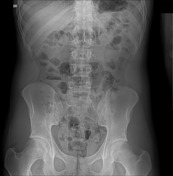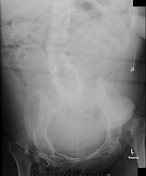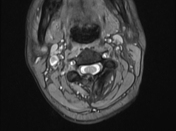47 results found
Article
Spina bifida occulta
Spina bifida occulta is the mildest form of spina bifida/spinal dysraphism and is a type of neural tube defect.
Terminology
While typically referring to asymptomatic posterior fusion defects, some authors 5 use it as a broad term that encompasses closed spinal defects such as:
diastematomyel...
Case
Spina bifida occulta

Published
29 Nov 2021
91% complete
X-ray
Case
Hip dislocation and spina bifida

Published
21 Mar 2018
91% complete
X-ray
Case
Spina bifida occulta

Published
07 Apr 2016
82% complete
X-ray
Case
Total sacral spina bifida occulta

Published
09 Mar 2020
95% complete
X-ray
CT
Case
Spina bifida: cervical spine

Published
26 Aug 2015
90% complete
X-ray
Case
Spina bifida

Published
18 Jun 2016
69% complete
X-ray
Case
Spina bifida occulta

Published
07 Nov 2018
72% complete
X-ray
Case
Spina bifida occulta - cervical spine

Published
20 Sep 2019
67% complete
X-ray
MRI
CT
Case
Spina bifida occulta

Published
05 May 2016
57% complete
X-ray
Case
Spina bifida occulta

Published
07 Jun 2020
54% complete
X-ray
Case
Spina bifida occulta

Published
09 Mar 2010
50% complete
CT
X-ray
Article
Rachischisis totalis
Rachischisis totalis, also known as complete spina bifida, refers to a severe form of spina bifida where there is a cleft through the entire spine.
Pathology
There is often a severe or complete defect of the neural tube involving the entire spine from the cervical region through to the sacrum....
Article
Clasp-knife deformity
Clasp-knife deformity is relatively common congenital anomaly found at the lumbosacral junction.
Terminology
When a clasp-knife deformity is accompanied by pain on extension secondary to protrusion of the enlarged spinous process (knife blade) into the sacral spinal canal, it is called clasp-k...
Article
Posterior vertebral fusion anomalies
Posterior vertebral fusion anomalies are relatively common and should not be mistaken for fractures. They are thought to be both developmental and pathological (e.g. spondylolysis) but are typically asymptomatic and incidental, and considered as anatomical variants. There are six types of poster...
Article
Charcot joint
Charcot joint, also known as a neuropathic joint or Charcot (neuro/osteo)arthropathy, refers to a progressive degenerative/destructive joint disorder in patients with abnormal pain sensation and proprioception.
Epidemiology
In modern Western societies by far the most common cause of Charcot jo...
Article
Charcot joint causes (mnemonic)
The causes of a Charcot joint can be remembered, using a mnemonic - with a little poetic license - as they (all) start with the letter S.
Mnemonic
s: sugar (diabetes)
s: syphilis
s: steroid use
s: syringomyelia
s: spinal cord injury
s: spina bifida
s: scleroderma
s: scaly disease (lepro...
Article
Unfused spinous process
Unfused spinous process, which is really failure of fusion of the neural arch, is a relatively common anatomical variant and is part of the spectrum of spina bifida occulta.
This should be differentiated from accessory ossicles of the spinous process, which appear after non-fusion of the secon...
Article
Congenital talipes equinovarus
Congenital talipes equinovarus is considered the most common anomaly affecting the feet diagnosed on antenatal ultrasound.
Terminology
While some use talipes equinovarus and clubfoot synonymously, in certain publications, the term clubfoot is considered a more general descriptive term that des...
Article
Aicardi syndrome
Aicardi syndrome is a rare severe developmental disorder. It results from an X-linked genetic defect that is fatal in males and therefore only manifests in females (except for rare 47, XXY cases).
Terminology
Aicardi syndrome is distinct from Aicardi-Goutieres syndrome although both are named ...









 Unable to process the form. Check for errors and try again.
Unable to process the form. Check for errors and try again.